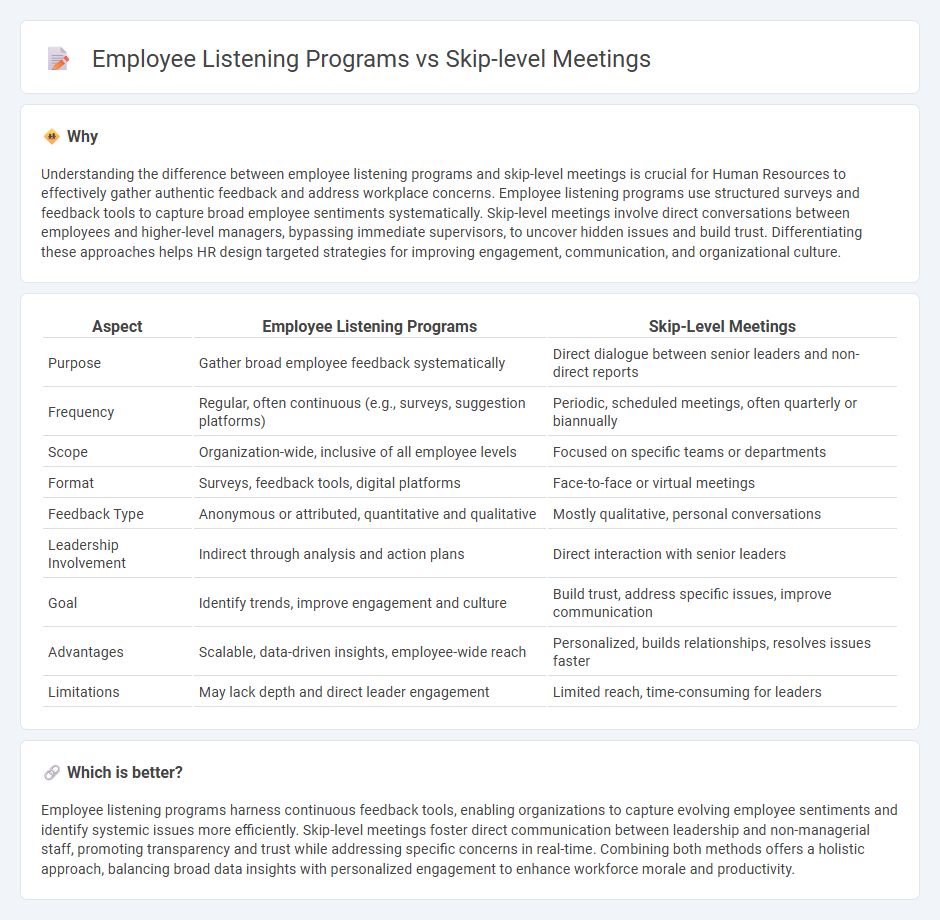
Employee listening programs systematically gather feedback through surveys and digital platforms to capture broad workforce sentiments and identify organizational issues. Skip-level meetings enable direct dialogue between employees and senior leaders, fostering transparency and uncovering insights beyond immediate supervisors' perspectives. Discover how integrating these approaches can enhance employee engagement and drive strategic HR decisions.
Why it is important
Understanding the difference between employee listening programs and skip-level meetings is crucial for Human Resources to effectively gather authentic feedback and address workplace concerns. Employee listening programs use structured surveys and feedback tools to capture broad employee sentiments systematically. Skip-level meetings involve direct conversations between employees and higher-level managers, bypassing immediate supervisors, to uncover hidden issues and build trust. Differentiating these approaches helps HR design targeted strategies for improving engagement, communication, and organizational culture.
Comparison Table
| Aspect | Employee Listening Programs | Skip-Level Meetings |
|---|---|---|
| Purpose | Gather broad employee feedback systematically | Direct dialogue between senior leaders and non-direct reports |
| Frequency | Regular, often continuous (e.g., surveys, suggestion platforms) | Periodic, scheduled meetings, often quarterly or biannually |
| Scope | Organization-wide, inclusive of all employee levels | Focused on specific teams or departments |
| Format | Surveys, feedback tools, digital platforms | Face-to-face or virtual meetings |
| Feedback Type | Anonymous or attributed, quantitative and qualitative | Mostly qualitative, personal conversations |
| Leadership Involvement | Indirect through analysis and action plans | Direct interaction with senior leaders |
| Goal | Identify trends, improve engagement and culture | Build trust, address specific issues, improve communication |
| Advantages | Scalable, data-driven insights, employee-wide reach | Personalized, builds relationships, resolves issues faster |
| Limitations | May lack depth and direct leader engagement | Limited reach, time-consuming for leaders |
Which is better?
Employee listening programs harness continuous feedback tools, enabling organizations to capture evolving employee sentiments and identify systemic issues more efficiently. Skip-level meetings foster direct communication between leadership and non-managerial staff, promoting transparency and trust while addressing specific concerns in real-time. Combining both methods offers a holistic approach, balancing broad data insights with personalized engagement to enhance workforce morale and productivity.
Connection
Employee listening programs enhance communication by systematically gathering feedback across all organizational levels, creating a comprehensive understanding of employee sentiment. Skip-level meetings facilitate direct dialogue between senior leaders and staff without intermediate managers, offering authentic insights that enrich these listening initiatives. Together, they foster a transparent culture and enable more effective human resource strategies by aligning leadership actions with frontline experiences.
Key Terms
Skip-level meetings:
Skip-level meetings foster direct communication between senior leaders and frontline employees, bypassing intermediate managers to identify challenges and opportunities firsthand. These meetings enhance transparency, build trust, and enable leaders to gather candid feedback that might be lost in traditional reporting structures. Explore how skip-level meetings can transform your organizational communication and employee engagement.
Leadership Communication
Skip-level meetings enhance leadership communication by enabling direct dialogue between top executives and frontline employees, fostering transparency and trust. Employee listening programs systematically gather feedback through surveys, pulse checks, and forums, providing leadership with data-driven insights to improve organizational culture. Explore how integrating both approaches can transform leadership communication and employee engagement.
Organizational Transparency
Skip-level meetings foster organizational transparency by creating direct communication channels between senior leaders and frontline employees, reducing hierarchical barriers that often obscure critical insights. Employee listening programs enhance transparency through continuous feedback mechanisms, enabling organizations to identify and address issues systematically at scale. Explore how integrating both approaches can transform transparency and trust within your organization.
Source and External Links
Skip Level Meetings - Overview - The GitLab Handbook - A skip-level meeting is where a manager's manager meets directly with team members without the immediate manager present, aiming to build rapport, gather feedback, and clarify objectives without managing priorities or performance directly.
Skip-Level Meeting: Questions And Tips For Employee Feedback - Skip-level meetings allow higher-level managers to connect with employees beneath their direct reports to gain unfiltered insights, build rapport, and understand frontline challenges and leadership effectiveness.
How to Use Skip-Level Meetings Effectively - The Management Center - Effective skip-level meetings should be scheduled consistently and transparently, include all indirect reports fairly, and avoid undermining direct managers' authority while ensuring clear communication of the meeting's purpose.
 dowidth.com
dowidth.com